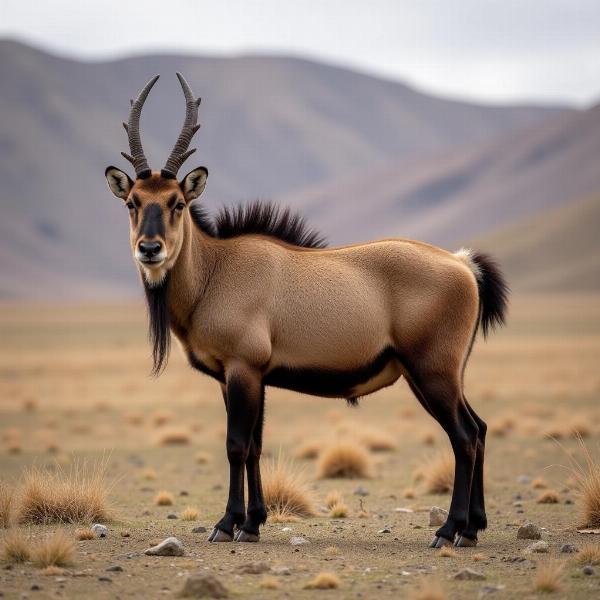Kyang meaning in Hindi often sparks curiosity among those unfamiliar with the Tibetan wild ass. This article delves into the various aspects of “kyang meaning in Hindi,” exploring its origins, cultural significance, and relevance in different contexts. We’ll also explore common misconceptions surrounding the term and provide accurate information to help you understand its true meaning.
What Does Kyang Actually Mean in Hindi?
While “kyang” doesn’t have a direct Hindi translation with the same cultural nuances, it’s often referred to as तिब्बती जंगली गधा (Tibbati Jangli Gadha), which literally translates to “Tibetan wild ass.” This accurately describes the animal itself – a wild equine native to the Tibetan Plateau. However, it doesn’t encompass the cultural significance the kyang holds for Tibetan communities. Understanding this distinction is crucial when exploring “kyang meaning in Hindi.”
 Tibetan Wild Ass grazing on the Tibetan Plateau
Tibetan Wild Ass grazing on the Tibetan Plateau
The kyang is deeply intertwined with Tibetan folklore and often symbolizes freedom, strength, and resilience. These connotations are often lost in the simple Hindi translation. Therefore, understanding the full “kyang meaning in Hindi” requires acknowledging both its literal meaning and its cultural context.
Kyang Beyond a Simple Translation
Exploring “kyang meaning in Hindi” opens a window into the rich tapestry of Tibetan culture. For nomadic communities, the kyang represents a connection to the land and a vital part of their ecosystem. It’s not just an animal; it’s a symbol of their heritage. This layered meaning adds depth to the understanding of “kyang meaning in Hindi” beyond a simple zoological definition.
Kyang in Popular Culture and Literature
While not as prevalent as other animals in Indian literature, the kyang sometimes appears in travelogues and accounts of journeys through the Tibetan Plateau. These accounts often highlight the kyang’s unique adaptation to the harsh environment and its role in the local ecosystem. Understanding how the kyang is portrayed in different media can further enrich the exploration of “kyang meaning in Hindi.”
Common Misconceptions about Kyang
One common misconception is that the kyang is a type of donkey. While it resembles a donkey in some ways, it’s actually more closely related to the horse. Another misunderstanding arises from the lack of a direct Hindi equivalent for “kyang.” This can lead to oversimplification of its meaning, overlooking its cultural significance.
Why is Understanding “Kyang Meaning in Hindi” Important?
Understanding “kyang meaning in Hindi” goes beyond mere linguistic curiosity. It promotes cultural sensitivity and appreciation for the diverse ecosystems and traditions of the Indian subcontinent. It also encourages a deeper understanding of the interconnectedness of language, culture, and the natural world.
Conclusion: Appreciating the Nuances of “Kyang Meaning in Hindi”
As we’ve explored, understanding “kyang meaning in Hindi” requires going beyond a literal translation. It involves recognizing the cultural and ecological significance of this unique animal. By appreciating these nuances, we can gain a richer understanding of both the Tibetan and Indian cultures and their interconnectedness.
FAQ:
- What is the scientific name of the kyang? Equus kiang.
- Is the kyang endangered? The kyang is classified as Least Concern by the IUCN, but its population is facing threats.
- Where can I see kyang in India? Kyang can be spotted in Ladakh, a region in northern India bordering Tibet.
- What is the difference between a kyang and a donkey? While they look similar, the kyang is more closely related to the horse and has distinct physical characteristics.
- Why is the kyang important to Tibetan culture? The kyang symbolizes freedom, strength, and resilience and is deeply connected to the nomadic lifestyle.
- Is there a specific Hindi word for “kyang”? No, the most commonly used term is तिब्बती जंगली गधा (Tibbati Jangli Gadha), meaning “Tibetan wild ass.”
- What is the kyang’s habitat? The kyang is native to the high-altitude Tibetan Plateau.
Meaning-Hindi.in is your premier destination for professional Hindi translation services. We specialize in a wide range of translation solutions, including business and commercial documents, legal and certified translations, technical manuals, website localization, educational and academic materials, and expedited translation services. Our team of expert linguists ensures accurate and culturally sensitive translations to meet your specific needs. Whether you need to translate your website for a wider Indian audience or require precise legal document translation, Meaning-Hindi.in has the expertise to deliver exceptional results. Contact us today at [email protected] or call us at +91 11-4502-7584 to discuss your translation requirements. Need a quick and accurate translation? Meaning-Hindi.in offers rapid turnaround times for urgent projects. Trust Meaning-Hindi.in for all your Hindi translation needs!